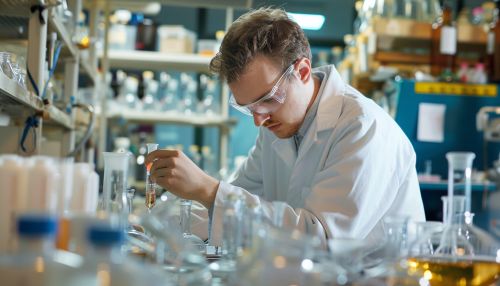Organic Synthesis: Difference between revisions
(Created page with "== Introduction == Organic synthesis is a specialized branch of chemical synthesis and is concerned with the construction of organic compounds via organic reactions. Organic molecules are often complex and can contain multiple functional groups, which makes their synthesis a challenging and intricate process. This field is fundamental to the development of pharmaceuticals, agrochemicals, and materials science. == Historical Background == The history of organic synthesis...") |
No edit summary |
||
| Line 59: | Line 59: | ||
Organic synthesis plays a crucial role in the development of new materials, such as polymers, dyes, and electronic materials. These materials have applications in various industries, including electronics, textiles, and packaging. | Organic synthesis plays a crucial role in the development of new materials, such as polymers, dyes, and electronic materials. These materials have applications in various industries, including electronics, textiles, and packaging. | ||
[[Image:Detail-93035.jpg|thumb|center|A chemist working in a laboratory, surrounded by glassware and chemical reagents.|class=only_on_mobile]] | |||
[[Image:Detail-93036.jpg|thumb|center|A chemist working in a laboratory, surrounded by glassware and chemical reagents.|class=only_on_desktop]] | |||
== Challenges in Organic Synthesis == | == Challenges in Organic Synthesis == | ||
Latest revision as of 21:52, 21 June 2024
Introduction
Organic synthesis is a specialized branch of chemical synthesis and is concerned with the construction of organic compounds via organic reactions. Organic molecules are often complex and can contain multiple functional groups, which makes their synthesis a challenging and intricate process. This field is fundamental to the development of pharmaceuticals, agrochemicals, and materials science.
Historical Background
The history of organic synthesis dates back to the early 19th century with the synthesis of urea by Friedrich Wöhler in 1828, which marked the first time an organic compound was synthesized from inorganic starting materials. This discovery challenged the prevailing belief in vitalism and laid the groundwork for modern organic chemistry.
Principles of Organic Synthesis
Organic synthesis relies on a deep understanding of organic reactions, mechanisms, and the reactivity of different functional groups. The principles of organic synthesis include:
Functional Group Interconversion
Functional group interconversion (FGI) involves the transformation of one functional group into another. This is a fundamental aspect of organic synthesis, enabling chemists to modify molecules to achieve the desired structure and reactivity.
Retrosynthetic Analysis
Retrosynthetic analysis is a problem-solving technique used by chemists to plan the synthesis of complex molecules. It involves breaking down a target molecule into simpler precursor structures, ultimately leading to commercially available starting materials.
Protecting Groups
Protecting groups are used to temporarily mask reactive functional groups during a multi-step synthesis. This allows for selective reactions to occur without interference from other functional groups in the molecule.
Types of Organic Reactions
Organic synthesis encompasses a wide variety of reactions, each with its own mechanisms and applications. Some of the key types of organic reactions include:
Addition Reactions
Addition reactions involve the addition of atoms or groups of atoms to a double or triple bond. Examples include hydrogenation, halogenation, and hydroboration.
Substitution Reactions
Substitution reactions involve the replacement of an atom or group of atoms in a molecule with another atom or group. These reactions can be classified as nucleophilic or electrophilic, depending on the nature of the substituent.
Elimination Reactions
Elimination reactions involve the removal of atoms or groups from a molecule, resulting in the formation of a double or triple bond. Common examples include dehydrohalogenation and dehydration.
Rearrangement Reactions
Rearrangement reactions involve the reorganization of the molecular structure without adding or removing atoms. These reactions often proceed through the migration of atoms or groups within the molecule.
Pericyclic Reactions
Pericyclic reactions are a class of reactions that proceed through a concerted mechanism involving cyclic transition states. Examples include the Diels-Alder reaction and sigmatropic rearrangements.
Strategies in Organic Synthesis
The synthesis of complex organic molecules often requires careful planning and strategy. Some common strategies include:
Linear Synthesis
Linear synthesis involves a straightforward sequence of reactions, where each step leads directly to the next. This approach is simple but can be inefficient for complex molecules.
Convergent Synthesis
Convergent synthesis involves the independent synthesis of key fragments, which are then combined in the final steps. This approach can be more efficient and allows for greater flexibility in the synthesis plan.
Divergent Synthesis
Divergent synthesis involves the generation of multiple products from a common intermediate. This strategy is useful for the rapid synthesis of compound libraries for drug discovery.
Applications of Organic Synthesis
Organic synthesis has a wide range of applications in various fields, including:
Pharmaceutical Industry
The pharmaceutical industry relies heavily on organic synthesis for the development of new drugs. Complex natural products and novel therapeutic agents are often synthesized through intricate synthetic routes.
Agrochemicals
Organic synthesis is essential for the development of agrochemicals, including pesticides, herbicides, and fungicides. These compounds help improve crop yields and protect against pests and diseases.
Materials Science
Organic synthesis plays a crucial role in the development of new materials, such as polymers, dyes, and electronic materials. These materials have applications in various industries, including electronics, textiles, and packaging.


Challenges in Organic Synthesis
Despite the advancements in organic synthesis, several challenges remain:
Selectivity
Achieving high selectivity in reactions, particularly in the presence of multiple functional groups, remains a significant challenge. Chemists often need to develop new reagents and catalysts to improve selectivity.
Yield
Maximizing the yield of each step in a multi-step synthesis is crucial for the overall efficiency of the process. Low yields can lead to significant material loss and increased costs.
Scalability
Scaling up laboratory-scale reactions to industrial-scale production can be challenging. Factors such as reaction conditions, heat transfer, and mixing need to be carefully optimized.
Future Directions
The field of organic synthesis continues to evolve, with ongoing research focused on:
Green Chemistry
Green chemistry aims to develop more sustainable and environmentally friendly synthetic methods. This includes the use of renewable feedstocks, reducing waste, and minimizing the use of hazardous reagents.
Automation and Machine Learning
Automation and machine learning are increasingly being integrated into organic synthesis. Automated synthesis platforms and predictive algorithms can accelerate the discovery and optimization of new reactions.
Biocatalysis
Biocatalysis involves the use of enzymes and microorganisms to catalyze organic reactions. This approach offers high selectivity and mild reaction conditions, making it an attractive alternative to traditional synthetic methods.
